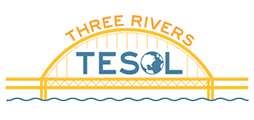 Constraints and Creativity in English Language Teaching at Literacy Pittsburgh
Constraints and Creativity in English Language Teaching at Literacy Pittsburgh
by Nicole Mannino Johnson
 Pre-pandemic, a day in the life teaching English to ELLs (English Language Learners) at Literacy Pittsburgh: get up, go to the Downtown Center, print out materials for students, go into the classroom where students all gather together in a space they make their own. Students greet one another, share snacks and candy, laugh together and learn together. Students enjoy their space and time and the Downtown Center where they can focus on improving their English and getting reprieve from the drudgery of daily life.
Pre-pandemic, a day in the life teaching English to ELLs (English Language Learners) at Literacy Pittsburgh: get up, go to the Downtown Center, print out materials for students, go into the classroom where students all gather together in a space they make their own. Students greet one another, share snacks and candy, laugh together and learn together. Students enjoy their space and time and the Downtown Center where they can focus on improving their English and getting reprieve from the drudgery of daily life.
On March 16th it all changed for everyone when we learned that we would be shutting down in-person teaching indefinitely, forcing a major constraint on us all. No more space to gather, no more sharing snacks, no idea how long we would be shut down. Our team quickly jumped into action to be sure the students understood that a shutdown was happening, and to check in on them to see how they were doing. Teachers called, texted, WhatsApped, and emailed students to touch base. The ELL team at Literacy Pittsburgh also brainstormed how to continue with our lessons. We decided to begin a YouTube channel and during our last day in the office, March 16th, a group of teachers began recording content to share with our students on YouTube.
Why YouTube? Accessibility, popularity, ease of use, and no cost. We had noticed that many students seemed to already be familiar with YouTube, as we had seen them watching YouTube on their smartphones. So, our first creative solution was to create a YouTube channel where we continued with the lessons students had already been working on. For many of the ELL levels, we offer reading classes – and students already had been immersed in a story – so we provided videos of comprehension activities, listening activities, and daily routine activities that students were familiar with. We felt it was important for our students to see our faces, and to hear our voices.
The next challenge was getting the word out. We began a massive effort to text or email students to tell them they could watch us on YouTube. Word spread quickly! From March 16 – April 22, our channel had more than 10,000 views with over 500 hours of watch time, and more than 135 subscribers. As of today, our channel has more than 31K views and more than 2.1K hours of watch time. And we know that it is our students watching. Many of our videos have instructions for students to further interact, such as writing homework and sending a picture of the homework to teachers or clicking on a link to Quizlet or Survey Monkey.
Once YouTube was established, Literacy Pittsburgh began offering live Zoom classes. Zoom was a major hurdle to explain to students at first. How were we going to explain what it was, and how to use it? We leaned on YouTube. We created videos telling students about Zoom and about how to download it. After we made the videos, we texted them to students, then followed up with phone calls to make sure the students received the message. We started with one or two Zoom classes. Now we offer classes at all levels from Foundations (Beginning Literacy) to Advanced. Teachers on our team are constantly innovating with instructional techniques online. At first we were just thrilled when students actually appeared in our virtual classrooms, now teachers are using breakout rooms, screen sharing, ‘teacher-less’ classes, and blending synchronous Zoom classes with asynchronous learning opportunities – including YouTube, Survey Monkey, Quizlet, packets that are sent via snail mail, Google Classroom, USA Learns, and more.
If you were to “drop in” today to one of our virtual classes, you may see students practicing new vocabulary with a Power Point game, students in a breakout room practicing conversation with guest facilitators, students leading a breakout room and sharing their own screens, students preparing for citizenship, entrance to post-secondary schools, or the workplace.
Students have adapted amazingly well and now have a virtual space in which to improve their learning. It is still a place where they can break from the rigors of everyday life and interact with friends, improve their English, which helps them do better at work or find a new job, or prepare for citizenship. Our team is proud that we have sustained community and relationships during this time of isolation. We are impressed with our students and their adaptability. While we didn’t choose this method of teaching, we have collectively and creatively shifted so that we can continue to meet the needs of our students.
Nicole Mannino Johnson is an ESL and Citizenship Instructor at Literacy Pittsburgh.
Next article: Transitioning to Remote Learning at Pittsburgh Public Schools
